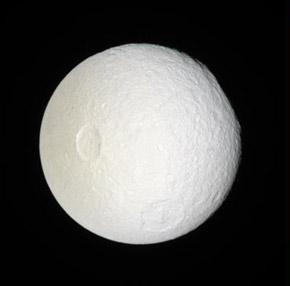Planetary Sandblaster
 [Image: "Saturn's moon Tethys bears the brunt of the particles spewing from its neighbour Enceladus – these particles seem to keep its surface clean and bright; photo via NASA/JPL/Space Science Institute and New Scientist].
[Image: "Saturn's moon Tethys bears the brunt of the particles spewing from its neighbour Enceladus – these particles seem to keep its surface clean and bright; photo via NASA/JPL/Space Science Institute and New Scientist]."Particles spewed from Saturn's moon Enceladus are sandblasting neighbouring moons, leaving them sparklingly bright," New Scientist reports.
Further: "If life exists beneath the surface of Enceladus, these particles might be spreading it to other moons."
The particles in question originate from a "giant water plume" on the moon's south pole. Wonderfully, these same particles go on to create – and continuously replenish – Saturn's so-called E ring.
"Internal heat must be driving all this activity," we read, "but the source of the heat remains a big puzzle. Natural radioactive decay in the moon's rocky core might warm the interior just enough to produce a sludgy plume of water and ammonia. This could heat the surface ice just enough to allow water to evaporate slowly." Other hypotheses suggest that Saturn's own gravitational pull is basically sloshing the poor moon into a constant state of eruption – a kind of astronomical vomitorium spraying uncontrollably through space...
Perhaps your next semester's landscape design assignment will include giving the Earth one or two of these things.





Comments are moderated.
If it's not spam, it will appear here shortly!
Post a Comment